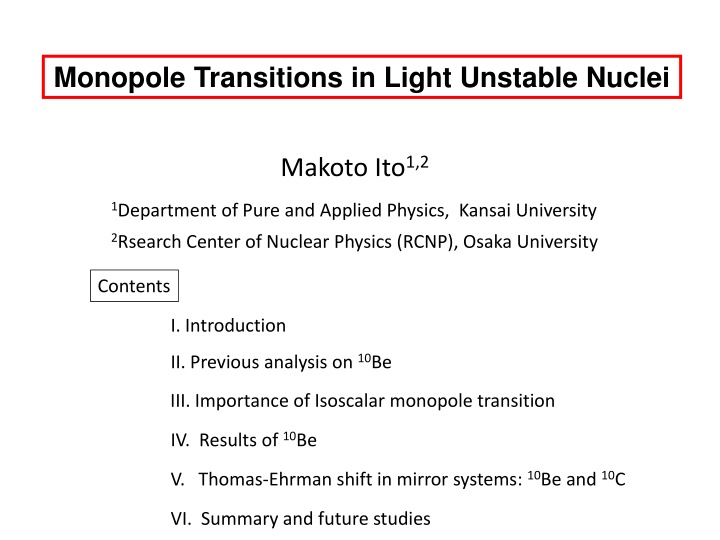
Monopole Transitions in Light Unstable Nuclei - Research Insights
Explore the analysis and significance of isoscalar monopole transitions in light unstable nuclei, with a focus on the study of 10Be. Discover the results, Thomas-Ehrman shift, and cluster structures in 4N nuclei, along with the extension of the MO model for highly excited states. Delve into previous studies on chemical bonding structures and reaction mechanisms in even Be isotopes. Learn about monopole excitation, cluster structures, and the isoscalar monopole transition in 10Be, shedding light on the development of cluster structures in final states.
Download Presentation

Please find below an Image/Link to download the presentation.
The content on the website is provided AS IS for your information and personal use only. It may not be sold, licensed, or shared on other websites without obtaining consent from the author. If you encounter any issues during the download, it is possible that the publisher has removed the file from their server.
You are allowed to download the files provided on this website for personal or commercial use, subject to the condition that they are used lawfully. All files are the property of their respective owners.
The content on the website is provided AS IS for your information and personal use only. It may not be sold, licensed, or shared on other websites without obtaining consent from the author.
E N D
Presentation Transcript
Monopole Transitions in Light Unstable Nuclei Makoto Ito1,2 1Department of Pure and Applied Physics, Kansai University 2Rsearch Center of Nuclear Physics (RCNP), Osaka University Contents I. Introduction II. Previous analysis on 10Be III. Importance of Isoscalar monopole transition IV. Results of 10Be V. Thomas-Ehrman shift in mirror systems: 10Be and 10C VI. Summary and future studies
IKEDA Diagram Cluster structures in 4N nuclei Ikeda s Threshold rules Molecular structures will appear close to the respective cluster threshold. Be isotopes Molecular Orbital (MO) picture -Particle Stable 3H+p 20 MeV Systematic Appearance of cluster structures + The MO model gives one of standard picture in the low-lying structure
Extension of the MO model Research subject: Structure changes beyond MO in the highly excited states Extension of the MO model is important on the wide structure changes Generalized Two-center Cluster Model (Example of 10Be) 10Be= + +N+N Dimer channels 6He 5He 5He Mol. Orb. Combine Combination of M.O. and Dimer channels :ROP77 (2015) ... S + + = C2 C3 C1 S, Ci : Variational PRM. 0Pi (i=x,y,z) Atomic Orbit at Left or Right side center
M. Ito and K. Ikeda, Report on Progress in Physics 77 (2014) Previous studies We have performed the unified studies of the chemical-bonding structure and reaction mechanism in even Be isotopes (A=10,12,14,16) Continuum region (Reaction problem) 10Be= + +2N Cluster Excitation Neutron Excitation Various structures are generated by cluster + neutrons Bound state region 10Be
Monopole excitation and cluster structures Enhancement of the monopole transition is a sign of the development of the cluster structure in final states A + i + ex = 2 ( , 0 ) 0 0 M E IS ir Cluster structure 1 = 1 Monopole and Clusters 2hw excitation of the clusters rel. motion + ( ) S . . 2 ( ) M IS G A Cluster rel Developed cluster Shell model = Melted Cluster Monopole operator induces 2hw Ex. for the clusters in G.S. = 2hw ex. Bayman-Bohr Theorem Strength in Ex < 15 MeV is possible T. Yamada et al., PTP120 (08) ( Lower strength is difficult in shell model )
A Isoscalar Monopole Transition in 10Be + i + ex = 2 ( ) 0 0 M IS ir 1 = 1 Strengths are comparable to M(IS)S.P. = 3.37 fm2 IS M p s ) ( . 04+ . = 2 1 0 p r p 03+ 4.00 fm2 M(IS) is prominently enhanced for 01+ 03+ Th. 02+ 8.26 fm2 Cluster s relative EX. 01+ 03+ 2.78 fm2 4 6 01+ 10Be 2hw Cluster ex.
He-He Relative wave functions (Reduced width) The 01+state (Compact Mol. Orb.) The 03+state (Developed + 6He) + 6Heg.s. + 6Heg.s. + 6He(2+) |r (r)| ( fm-1/2) |r (r)| ( fm-1/2) 2hw Ex. + 6He(2+) r ( fm ) r ( fm ) Radial excitation of the relative wave function occurs in 01+ 03+ 01+ 03+ are connected by the monopole (2hw ex.) operator
Variety of Nuclear Chemical Clusters 12Be = + + 4N Question Structure is abundant Degenerate M(IS) strength appear at Ex. < 15 MeV What is a variation in replacing core or valence neutrons ? ROP 77 096301 (2014) + 2N 12C 2N 2P 10Be = + + 2N Coulomb Effect (Thomas-Ehrman Shift) 10C = + + 2P 18O = + 12C + 2N
J=0+Levels 10Be 10C ( )2 In continuum, we solved the scattering problem 1.6 MeV 04+ 2+ 0.9MeV 03+ Developed Cluster (S-wave) Energy ( MeV ) ( +)2 Th. 1.3 MeV 02+ Suppressed Coulomb shift ( )2 2.3 MeV Cluster s Thomas Ehrman Shift (TES) 01+
10Be = + 6He and 10C = + 6Be wave function 10Be = +6Heg.s. 10C = +6Beg.s. 01+:( 3/2 )2 01+:( 3/2 )2 |r (r)| ( fm-1/2) |r (r)| ( fm-1/2) 02+:( 1/2+)2 02+:( 1/2+)2 r ( fm ) r ( fm ) W.F. of 02+is more extended than W.F. of 01+ Coulomb repulsion is suppressed for the 02+state
01+ 03+ Monopole transition in 10C and 10Be 4 6 2hw Cluster ex. Theoretical Prediction of M(IS) E(02+) ( MeV ) Theory M(IS) ( fm2) 01+ 02+ M(IS) ( fm2) 01+ 03+ M(IS) ( fm2) 01+ 04+ r.m.s. ( fm ) 2.66 4.90 2.78 8.26 4.00 10Be 10C 2.73 4.00 5.27 7.55 2.90 MO EX. Cluster EX. MO EX. 1. All the strengths are comparable to or larger than M(IS)S.P. = 3.37 fm2 M(IS) is prominently enhanced for the clusters relative excitation. 2. M(IS) of 01+ 02+is not charge-symmetric in 10Be and 10C Due to the Cluster TES ( E=0.9 MeV) appearing n 10C.
M. Ito and K. Ikeda, Rep. on Prog. in Phys., 77 096301 (2014) Summary We have investigated the structure changes of the two-center systems and the enhancement of the IS monopole transition. Results 1. Chemical bonding structure and M(IS) transition in 10Be Wide variety appears by the combination of cluster-core and excess-nucleons IS monopole transition has a strong responsibility for the cluster excitation 2. Analysis of the mirror system, 10Be and 10C Suppression of the Coulomb shift Suppression occur in the cluster state (Spatially extended structure) Monopole transition Asymmetry in the 01+ 02+ transition is predicted Analysis of the mirror system will give an important information on the spatially extended cluster structure in the excited state cf. 8C-8He, by T. Myo and K. Kato,PTEP2014,083D01

